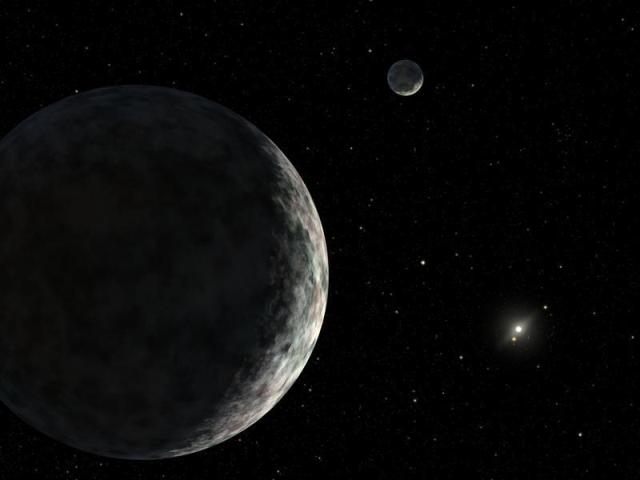Apr 24 2015
Celestial bodies made up of frozen water orbit not only at the outer limits of our solar system but also further inside.
 Dwarf with a moon: This artist’s impression shows Eris and its moon Dysnomia. The bright star on the right is our Sun. © NASA / JPL-Caltech
Dwarf with a moon: This artist’s impression shows Eris and its moon Dysnomia. The bright star on the right is our Sun. © NASA / JPL-Caltech
On 6 November 2010, the light of the star known as NOMAD1 0856-0015072 in the Cetus constellation dimmed. What had happened? A dwarf planet at the edge of the solar system had moved in front of the distant star - its name: Eris. Such a “stellar eclipse” affords astronomers a rare opportunity to find out more about the icy worlds which circle the Sun en masse beyond Neptune’s orbit.
Eris is not very popular with dyed-in-the-wool Pluto fans, as it was ultimately its discovery which expelled Pluto from the family of large planets in 2006. Some years before that, astronomers had tracked down the first, albeit smaller members of Eris’ type in the so-called Kuiper belt; the first one was captured in 1992.
Well over a thousand objects orbit in the tyre-like outer zone of the solar system and fill today’s astronomical catalogues. These range from miniature rocks the size of a tower block through to large dwarf planets such as Eris, measuring thousands of kilometres. The total mass of the Kuiper belt is estimated to be around 0.1 terrestrial masses – considerably more than in the main belt of the asteroids between Mars and Jupiter.
What these distant, very icy bodies look like is not yet known. In a telescope, they are merely unstructured spots of light - even with the highest magnification. The race to obtain the first portrait photo of such a dwarf world has meanwhile been won by Dawn – with an object whose orbit is much closer to the Sun: the image of Ceres was taken by the space probe’s onboard cameras, the so-called Framing Cameras, which originate, however, from the Max Planck Institute for Solar System Research in Göttingen.
The fact that icy bodies should exist relatively close to the Sun was surprising, according to Andreas Nathues. “But Ceres’ low average density cannot be explained in any other way than by a high proportion of water,” says the Max Planck researcher. Other bodies, such as the asteroid Themis – whose diameter of around 200 kilometres makes it significantly smaller than Ceres (equator diameter: 974 kilometres) – turned out in recent years to be at least partially covered with ice.
Dawn had already visited the Vesta asteroid four years ago – a rocky world, very probably without any ice. What differences do the two asteroids exhibit from the perspective of the onboard cameras? “The seven colour filters of the Framing Cameras provide us with a very sensitive measuring instrument for the spectral differences,” says Nathues. “And these are considerable. Vesta’s surface is much brighter than Ceres’ surface for the most part and has strong absorption lines at a wavelength of around 1000 nanometres, while Ceres has a steep drop in the violet and ultraviolet light below 450 nanometres. The corresponding drop in brightness with Vesta is much more moderate.”
What causes this so-called UV drop-off with Ceres must still be brought to light by further analyses. The indications that it consists partly of ice become particularly clear if the images of Ceres are looked at through the eyes of a geologist. These images show comparatively young landscapes, for example the walls of some impact basins that have become significantly flatter throughout geological ages.
“The material is possibly similar to that of terrestrial glaciers which flow down a slope. This is a strong indication for a viscous material that very likely acquires its properties because the ground consists partly of ice,” says Nathues.
The spatial distribution of ice was a key factor in the formation of the celestial bodies of the solar system. In general, the raw material for the formation of planets originates from large molecular clouds containing gas and dust. In greatly simplified terms, the gas – mainly hydrogen – is the raw material for the star which is formed when the masses of gas collapse. Planets stem from protoplanetary disks that form around young stars in these molecular clouds.
Text: Thorsten Dambeck
Source: http://www.mpg.de/